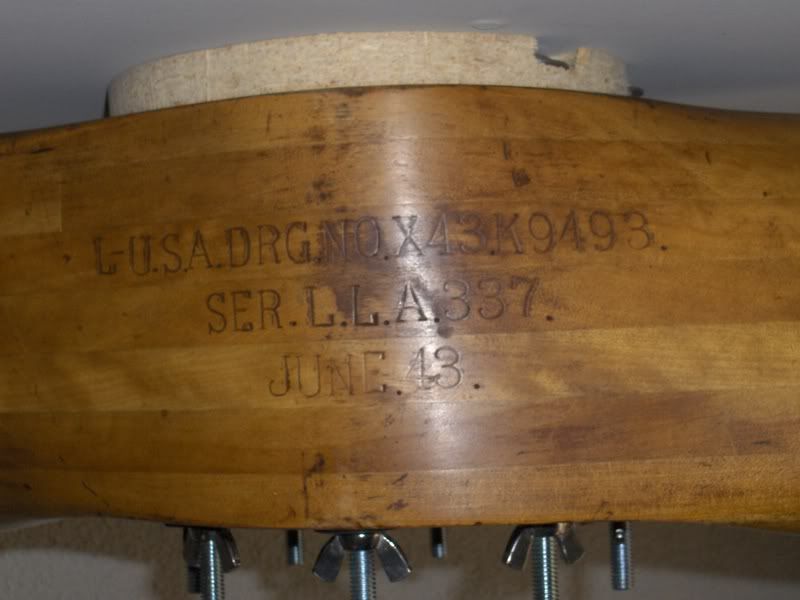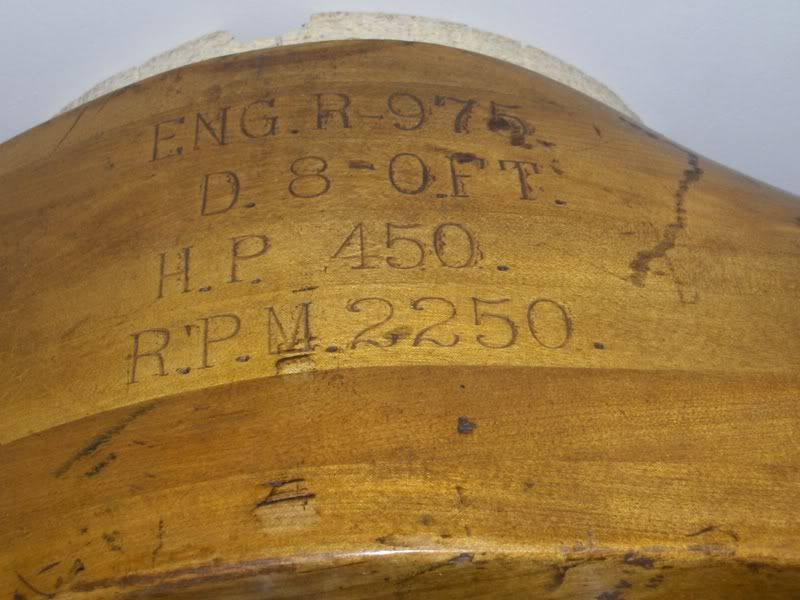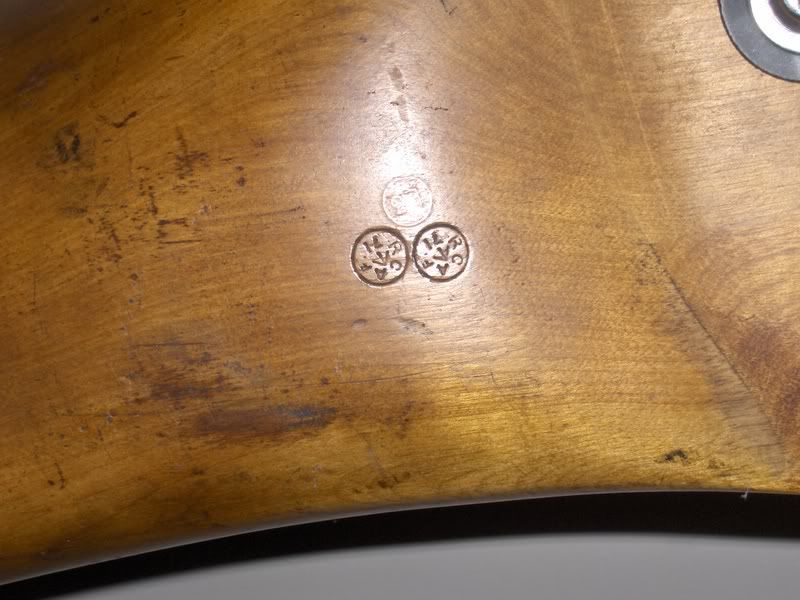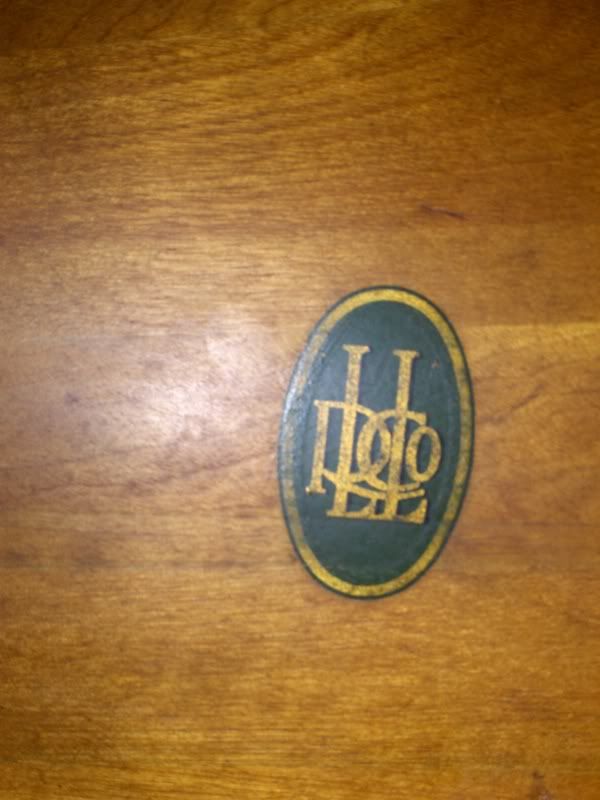Post # http://woodenpropeller.com/forum/viewtopic.php?t=67
Well here is mine! I *think* I have found out who the maker of my 90 inch prop is after more then a year of searching.
Drawing# is US registered Date: June 1943 and Serial # is 337th of this design made

Engine Spec / Type = Wright R-975 Whirlwind

RCAF inspection stamps

Mystery Prop maker logo, RLLCo = Laidlaw Lumber Company!!! The "R" in the logo stands for "Robert" as in Robert L Laidlaw founder of the company - hence the Logo lettering stands for Robert Laidlaw Lumber Co.

Mounted over all shot

This company was founded in 1886 and dissolved in 1972. (Not affiliated with the Laidlaw Transport Company - thats a different group) It still maintains a charity with assets close to 60 million (Y 1999) giving out grants to the arts, environmental groups and youth services. The company was based in Toronto with mills in different areas of Northern Ontario including Thunder Bay.
My next quest is to find out A: Where the plant was, B: What types of prop's they made and C: Which aircraft they were fitted to.
One assumes that the company was only into the making of prop's as part of the support of the war effort and with the advent of metal, full feathering units - went back to making fine furniture.
I suspect that my prop was used on an Anson mark 4 and considering that there was a group of aircraft (some were Anson's) in a farmers field near Dunnville Ontario sometime in the 70's
When I find out more I'll post it here.
Please help me identify.
Marking
L-USA DRG No X43K9493
SER LL A26
MAR 43
Marking
L-USA DRG No X43K9493
SER LL A26
MAR 43
Drawing# is US registered Date: June 1943 and Serial # is 337th of this design made

Engine Spec / Type = Wright R-975 Whirlwind

RCAF inspection stamps

Mystery Prop maker logo, RLLCo = Laidlaw Lumber Company!!! The "R" in the logo stands for "Robert" as in Robert L Laidlaw founder of the company - hence the Logo lettering stands for Robert Laidlaw Lumber Co.

Mounted over all shot

The Toronto Daily Star
January 6, 1940, p. 19-20
HIS JOB TO OK EVERY WARPLANE
'SO I'LL BE BUSY'
Youthful Test Pilot Proud of His Embryo Sky Babies
MANY IN MAKING
A smiling young man who looks a bit like Lindbergh pointed to row after row of welded frames and said: "Pretty soon I am going to be a busy man."
The young man was Bruce Douglas, slim and good-looking chief test pilot for DeHavilland Aircraft of Canada, and the welded frames where the beginning of aircraft to train thousands of fighting pilots.
Bruce puts though its paces every plane turned out by his company before delivery, and soon hundreds of them will be coming off the line. One look inside the plant at the rows of embryo aircraft would be enough to make Herr Hitler wonder why he started this war.
William Caulder, plant superintendent, guided a reporter and photographer for The Star from building to building, pointing out the geared-for-war facilities that will enable this plant alone to turn out many more aircraft per year than were turned out last year by all Canada's air fractories put together.
A plane a day could be produced comparatively effortlessly.
The plane being turned out is the famed Tiger Moth, many of which are already being used by flying clubs and R.C.A.F. stations in Canada, and for training purposes by the Royal Air Force. A two place biplane, it is being made 100 percent in Canada, with the exception of the engine, which is bought from England.
The original Tiger was designed and built in England, but the machine being produced for the Royal Canadian Air Force and the empire training scheme has modifications especially adapted for Canadian training conditions.
Since plenty of training will be done in sub-zero weather, the Canadian machine has a heater. It also has a coupe top, whereas the English model has open cockpits.
While propellers are being made by Laidlaw Lumber Co. , Toronto, and the skis by the famed Elliot brothers of Sioux Lookout, every other part is being made at the De Havilland factory.
January 6, 1940, p. 19-20
HIS JOB TO OK EVERY WARPLANE
'SO I'LL BE BUSY'
Youthful Test Pilot Proud of His Embryo Sky Babies
MANY IN MAKING
A smiling young man who looks a bit like Lindbergh pointed to row after row of welded frames and said: "Pretty soon I am going to be a busy man."
The young man was Bruce Douglas, slim and good-looking chief test pilot for DeHavilland Aircraft of Canada, and the welded frames where the beginning of aircraft to train thousands of fighting pilots.
Bruce puts though its paces every plane turned out by his company before delivery, and soon hundreds of them will be coming off the line. One look inside the plant at the rows of embryo aircraft would be enough to make Herr Hitler wonder why he started this war.
William Caulder, plant superintendent, guided a reporter and photographer for The Star from building to building, pointing out the geared-for-war facilities that will enable this plant alone to turn out many more aircraft per year than were turned out last year by all Canada's air fractories put together.
A plane a day could be produced comparatively effortlessly.
The plane being turned out is the famed Tiger Moth, many of which are already being used by flying clubs and R.C.A.F. stations in Canada, and for training purposes by the Royal Air Force. A two place biplane, it is being made 100 percent in Canada, with the exception of the engine, which is bought from England.
The original Tiger was designed and built in England, but the machine being produced for the Royal Canadian Air Force and the empire training scheme has modifications especially adapted for Canadian training conditions.
Since plenty of training will be done in sub-zero weather, the Canadian machine has a heater. It also has a coupe top, whereas the English model has open cockpits.
While propellers are being made by Laidlaw Lumber Co. , Toronto, and the skis by the famed Elliot brothers of Sioux Lookout, every other part is being made at the De Havilland factory.
My next quest is to find out A: Where the plant was, B: What types of prop's they made and C: Which aircraft they were fitted to.
One assumes that the company was only into the making of prop's as part of the support of the war effort and with the advent of metal, full feathering units - went back to making fine furniture.
I suspect that my prop was used on an Anson mark 4 and considering that there was a group of aircraft (some were Anson's) in a farmers field near Dunnville Ontario sometime in the 70's
When I find out more I'll post it here.
Comment